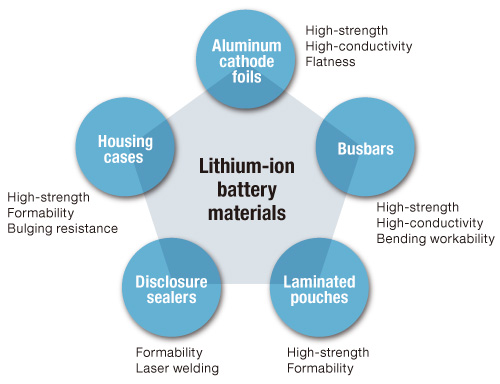Lithium Ion Battery Materials: What Do They Have?

The world is moving towards a new age where the humans are striving to create cleaner forms of energy than the ones produced by fossil fuels. Batteries and certain other renewable resources lead the race to replace fossil fuels. Therefore, batteries have taken up an important role in our lives.
The technological advances have also been ground breaking in the recent years. Our dependence on gadgets have prompted further rise in demand in batteries. The requirement of mobility has identified batteries as the ideal source of power for our gadgets, making them indispensable.
The lithium Ion batteries are considered to be the most popular among the kinds of batteries available. This is largely due to their long life cycles, easy and quick charging and non-polluting nature. Lithium ion batteries, have faced a stellar rise in demands as a mixture of various factors coming together.
Components of Lithium Ion Battery:
Lithium Ion battery is known to be made up of various components. There are primarily 4 different Lithium Ion Battery Materials that make up a battery cell. These are Anode, Cathode, Separators and Electrolytes.
Cathode:The top-quality batteries usually have lithium oxides, vanadium oxides, and rechargeable lithium oxides as the cathode. Layered oxides of cobalt and nickel are themost ideal material to be used as cathode. But, the rarity and toxicity of cobalt hasprevented it from large scale usage. Manganese offers low-cost substitution but the cyclelife it offers is very low.Cathode is primarily responsible for determining the characteristics of a battery. The voltage offered and battery’s capacity is determined by the cathode material used.
Anode: Lithium, graphite, lithium-alloying materials, inter metallic, and silicon are allsuitable to be used as Anode material. Lithium is most commonly used as an anode materialbut has performance issues when it comes to recharge cycles. It suffers from low rechargecycles. The dendritic growth of lithium is yet another point of concern. The dendritic growthleads to eventual short circuits. Graphite is commonly used as the anode material. The low cost, stability of structure, low electrical reactivity and conditions for storing lithium ions make graphite suitable to be used as anode.
Electrolyte: A robust electrolyte is the key to a good battery. An ideal electrolyte must becapable of withstanding high voltages, have a long shelf life and also provide a medium forseamless travelling of the Lithium ion.
Separator: Validating its name, a separator separates the anode and cathode to preventshort-circuits.



Comments
Post a Comment